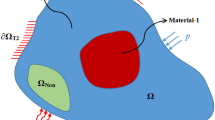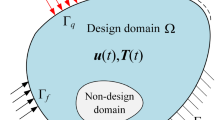Abstract
The design of thermal structures in the aerospace industry, including exhaust structures on embedded engine aircraft and hypersonic thermal protection systems, poses a number of complex design challenges. These challenges are particularly well addressed by the material layout capabilities of structural topology optimization; however, no topology optimization methods are readily available with the necessary thermoelastic considerations for these problems. This is due in large part to the emphasis on cases of maximum stiffness design for structures subjected to externally applied mechanical loads in the majority of topology optimization applications. In addition, while limited work in the literature has investigated thermoelastic topology optimization, a direct treatment of thermal stresses is not well documented. Such a treatment is critical in the design of thermal structures where excessive thermal stresses are a primary failure mode. In this paper, we present a method for the topology optimization of structures with combined mechanical and thermoelastic (temperature) loads that are subject to stress constraints. We present the necessary steps needed to address both the design-dependent thermal loads and accommodate the challenges of stress-based design criteria. A relaxation technique is utilized to remove the singularity phenomenon in stresses and the large number of stress constraints is handled using a scaled aggregation technique that has been shown previously to satisfy prescribed stress limits in mechanical problems. Finally, the stress-based thermoelastic formulation is applied to two numerical example problems to demonstrate its effectiveness.













Similar content being viewed by others
References
Bendsøe MP, Sigmund O (2003) Topology Optimization: Theory, Methods and Applicationsr, 2nd. Springer
Bruggi M (2008) On an alternative approach to stress constraints relaxation in topology optimization. Struct Multidiscip Optim 36(2):125–141
Bruggi M, Venini P (2008) A mixed FEM approach to stress-constrained topology optimization. Int J Numer Methods Eng 73(12):1693–1714
Bruns TE, Tortorelli DA (2001) Topology optimization of non-linear elastic structures and compliant mechanisms. Comput Methods Appl Mech Eng 190(26-27):3443–3459
Deaton JD, Grandhi RV (2013) Stiffening of restrained thermal structures via topology optimization. Struct Multidiscip Optim 48(4):731–745
Deaton JD, Grandhi RV (2014a) A survey of structural and multidisciplinary continuum topology optimization: post 2000. Struct Multidiscip Optim 49(1):1–38. doi:10.1007/s00158-013-0956-z
Deaton JD, Grandhi RV (2014b) Significance of Geometric Nonlinearity in the Design of Thermally Loaded Structures. AIAA Journal of Aircraft
Duysinx P, Bendsøe MP (1998) Topology optimization of continuum structures with local stress constraints. Int J Numer Methods Eng 43(8):1453–1478
Gao T, Zhang W (2010) Topology optimization involving thermo-elastic stress loads. Struct Multidiscip Optim 42(5):725–738
Guilherme CEM, Fonseca JSO (2007) Topology optimization of continuum structures with epsilon-relaxed stress constraints. In: Alves M, Da Costa Mattos H (eds) International Symposium on Solid Mechanics, Mechanics of Solids in Brazil, vol 1, Brazilian Society of Mechanical Sciences in Engineering, pp 239–250
Haney MA, Grandhi RV (2009) Consequences of material addition for a beam strip in a thermal environment. AIAA J 47(4):1026–1034
Holmberg E, Torstenfelt B, Klarbring A (2013) Stress constrained topology optimization. Struct Multidiscip Optim 48(1):33–47. doi:10.1007/s00158-012-0880-7
Jog C (1996) Distributed-parameter optimization and topology design for non-linear thermoelasticity. Comput Methods Appl Mech Eng 132(1-2):117–134
Kim WY, Grandhi RV, Haney MA (2006) Multiobjective Evolutionary Structural Optimization Using Combined Static/Dynamic Control Parameters. AIAA J 44(4):794–802
Le C, Norato J, Bruns TE, Ha C, Tortorelli DA (2010) Stress-based topology optimization for continua. Struct Multidiscip Optim 41(4):605–620
Lee E, James KA, Martins JRRA (2012) Stress-constrained topology optimization with design-dependent loading. Struct Multidiscip Optim 46(5):647–661
Li Q, Steven GP, Xie Y (1999) Displacement minimization of thermoelastic structures by evolutionary thickness design. Comput Methods Appl Mech Eng 179(3-4):361–378
Li Q, Steven GP, Xie YM (2001) Thermoelastic Topology Optimization for Problems with Varying Temperature Fields. J Therm Stresses 24(4):347–366
MathWorks (2012) Matlab release (2012b) Tech. MA, Natick
MIL-HDBK-5H (1998) Metallic Materials and Elements for Aerospace Vehicle Structures. Tech. Rep. MIL-HDBK-5H, U.S. Department of Defense
París J, Navarrina F, Colominas I, Casteleiro M (2010a) Block aggregation of stress constraints in topology optimization of structures. Adv Eng Softw 41(3):433–441
París J, Navarrina F, Colominas I, Casteleiro M (2010b) Improvements in the treatment of stress constraints in structural topology optimization problems. J Comput Appl Math 234(7):2231–2238
Pedersen P, Pedersen NL (2010) Strength optimized designs of thermoelastic structures. Struct Multidiscip Optim 42(5):681–691
Pedersen P, Pedersen NL (2012) Interpolation/penalization applied for strength design of 3D thermoelastic structures. Struct Multidiscip Optim 42(6):773–786
Penmetsa RC, Grandhi RV, Haney M (2006) Topology Optimization for an Evolutionary Design of a Thermal Protection System. AIAA J 44:2663–2671
Pereira J, Fancello E, Barcellos C (2004) Topology optimization of continuum structures with material failure constraints. Struct Multidiscip Optim 26(1-2):50–66
Rodrigues H, Fernandes P (1995) A material based model for topology optimization of thermoelastic structures. Int J Numer Methods Eng 38(12):1951–1965
Sigmund O (2001a) Design of multiphysics actuators using topology optimization - Part I: One-material structures. Comput Methods Appl Mech Eng 190(49-50):6577–6604
Sigmund O (2001b) Design of multiphysics actuators using topology optimization - Part II: Two-material structures. Comput Methods Appl Mech Eng 190(49-50):6605–6627
Sigmund O, Maute K (2013) Topology optimization approaches. Struct Multidiscip Optim 48(6):1031–1055
Sigmund O, Petersson J (1998) Numerical instabilities in topology optimization: a survey on procedures dealing with checkerboards, mesh-dependencies, and local minima. Struct Multidiscip Optim 16(1):68–75
Sigmund O, Torquato S (1997) Design of materials with extreme thermal expansion using a three-phase topology optimization method. Journal of the Mechanics and Physics of Solids 45(6):1037– 1067
Svanberg K (2002) A class of globally convergent optimization methods based on conservative convex separable approximations. SIAM J Optim 12(2):555–573
Wang B, Yan J, Cheng G (2011) Optimal structure design with low thermal directional expansion and high stiffness. Eng Optim 43(6):581–595
Xia Q, Wang MY (2008) Topology optimization of thermoelastic structures using level set method. Comput Mech 42(6):837– 857
Yan J, Cheng G, Liu L (2008) A uniform optimum material based model for concurrent optimization of thermoelastic structures and materials. Int J Simul Multidiscip Des Optim 2:259–266
Acknowledgments
This work has been funded by the U.S. Air Force Research Laboratory (AFRL) through contract FA8650-09-2-3938, the Collaborative Center for Multidisciplinary Sciences (CCMS). The views and conclusions contained herein are those of the authors and should not be interpreted as representing official policies or endorsements, either expressed or implied, of the Air Force Research Laboratory or the U.S. Government. We would also like to thank the reviewers. Their insightful comments undoubtedly helped increase the clarity and technical rigor of this paper.
Author information
Authors and Affiliations
Corresponding author
Rights and permissions
About this article
Cite this article
Deaton, J.D., Grandhi, R.V. Stress-based design of thermal structures via topology optimization. Struct Multidisc Optim 53, 253–270 (2016). https://doi.org/10.1007/s00158-015-1331-z
Received:
Revised:
Accepted:
Published:
Issue Date:
DOI: https://doi.org/10.1007/s00158-015-1331-z




